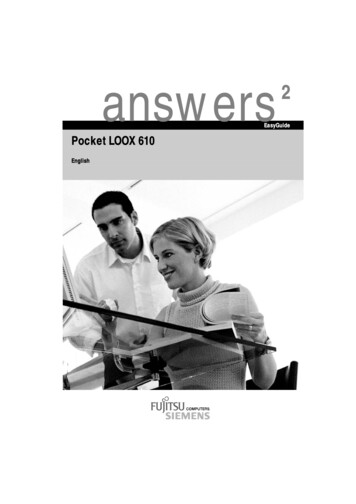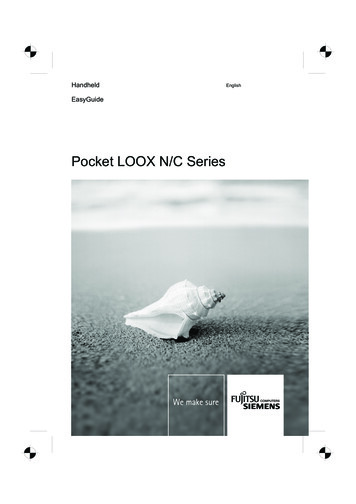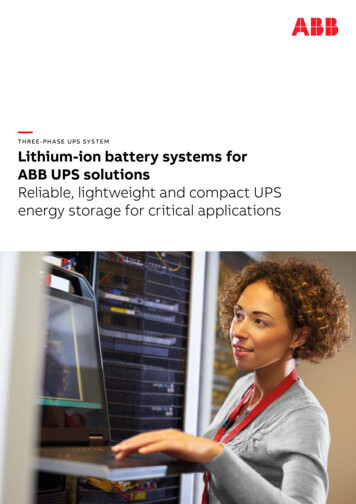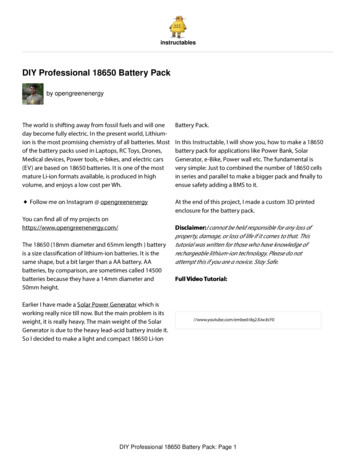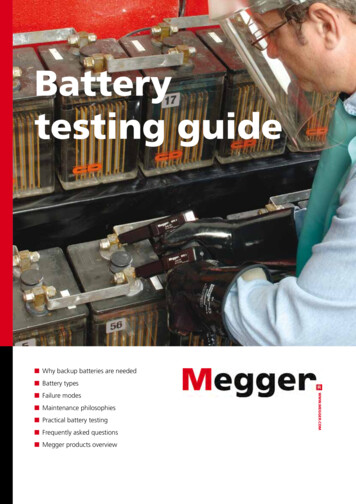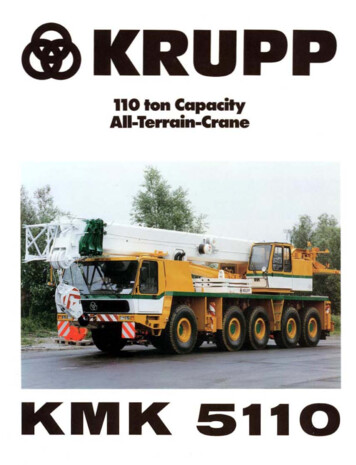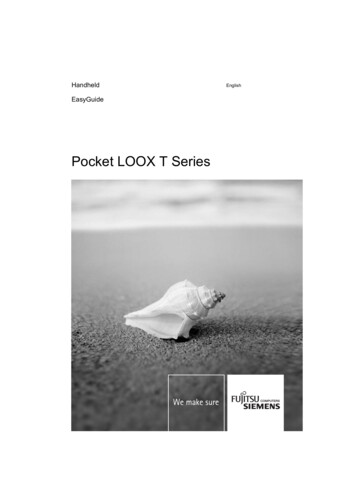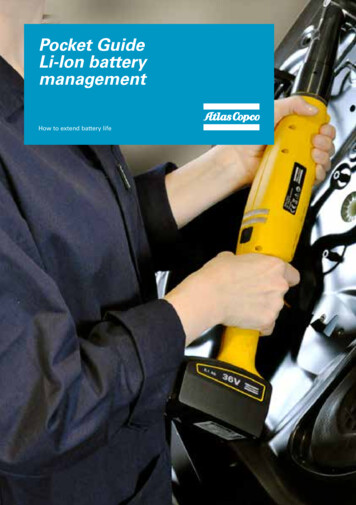
Transcription
Pocket GuideLi-Ion batterymanagementHow to extend battery lifeATLAS COPCO LITHIUM-ION BATTERIES. POCKET GUIDE
2
ContentsSpecifications – General.4Charging.5Usage.6Handling and First aid measures.7Service life.8Storage.9Recycling. 10Transportation. 11Regulations.12ATLAS COPCO LITHIUM-ION BATTERIES. POCKET GUIDE
General SpecificationsAtlas Copco Lithium-ion batteries are designed for power withmaintained high current output availability. The available currentoutput is not dependent on the remaining power level, meaningexcellent capacity is provided even during heavy duty use.Always read the Safety Information accompanying your battery whenpurchased to make sure the battery is handled in a correct way.4
ChargingDo not charge a damaged battery! Only use chargers approved byAtlas Copco. Normal charging time for a fully discharged batterydepends on capacity, battery size and type of charger, see SafetyInformation for your battery type. Always charge batteries maintainingthe safety distance prescribed in the Safety Information.”However, storing batteries in fully charged state causes aging andshortens battery life time. The battery should never be charged below0 C, as this imposes safety risks. All Atlas Copco chargers monitorsthe battery temperature and only allows charging if the batterytemperature is within permitted range. The charger will only allow tocharge supported batteries. The charger is set to charge the batteryto a specific voltage for optimal performance and high safety of thebattery.If unusual noise or heat is identified during charging, unplug thecharger and leave the battery for at least 12 hours. Contact safetypersonnel for further instructions.ATLAS COPCO LITHIUM-ION BATTERIES. POCKET GUIDE
50 C20-25 CUsageLithium-ion batteries perform best at around room temperature(20 C – 25 C). If used for long periods using high power, the batterywill heat up thus aging the battery. If possible, let the battery rest forsome time between high power pulses.When using at very low temperatures ( 0 C), try to avoid highpower pulses as they are harmful to the battery and increase aging.Pre-heating the battery to room temperature is a good solution incold environments. When changing a battery or attaching a newbattery to the tool, make sure the battery is correctly attached toavoid unintentional disconnection of the battery and possible batterydamage by the battery hitting the floor. To slide the battery intoposition should work very easy without high mechanical pressure.The battery can be mounted in two directions which allows the toolto be used in cramped spaces. Batteries should be disconnected fromthe power tool during longer shut down periods (e.g. weekends andholiday brakes).6
Handling and First aid measuresBatteries should always be handled with care,as they contain a lot of power and energy. Donot touch the terminals, as it can cause electricalshock which can lead to muscle paralyzingeffects such as sudden cardiac arrest, respiratoryparalysis, or ventricular fibrillation.Do not tamper with the battery, or try to openit. Avoid dropping batteries to the ground, or inother ways mechanically damage them, as this isa potential safety risk. Keep away from water orother liquids. Keep the batteries away from directsunlight for extended periods of time, and keepaway from heat sources, fires etc. at all times.If a battery shows signs of damage or have beendropped, scrap and replace it. If the battery isleaking liquids, do not touch them as they aretoxic and cause skin irritation or burns anddispose of the leaking battery. If leaking liquidscome in contact with the skin, wash with soapand cold water for at least 15 minutes and removecontaminated garments. Seek medical attention ifnecessary. If leaking liquids come in contact withthe eyes, do not rub eyes and immediately flusheyes thoroughly with cold water for at least 15minutes, then seek immediate medical attention.If leaking gases are inhaled, move to fresh air,monitor breathing and blood circulation, takeappropriate first aid/CPR actions if necessary,then immediately seek medical attention.In case of smoke from the battery or a thermalrunaway,use a dry powder extinguisher. For moreinformation, see the product safety data sheet.ATLAS COPCO LITHIUM-ION BATTERIES. POCKET GUIDE
Service lifeUnder normal usage, the battery will provide around 500 charge/discharge cycles before declared at end-of-life (80 % of nominalcapacity). To achieve the longest possible service life it is important toavoid very high and very low temperatures within the battery, as wellas long, high-current pulses.Even though the battery has a specified allowed operationaltemperature of -20 C to 60 C, it will provide the longest service life iftemperatures are kept within approximately 10 C to 40 C at all times.It is important to remember that the battery ages even when not used.To maximize service life, store batteries at low temperatures(10 C – 20 C) and low humidity ( 50 % relative humidity) when notused, and avoid storing the battery at full charge.8
StorageThe most important thing to remember when storing lithium-ionbatteries is to avoid storing them fully charged, as this will age thebattery greatly. Instead, store them below 80 % state-of-charge tomaximize service life.Optimally, the batteries should be stored at 30-40 % state-of-charge.Routinely check the charge level of batteries in storage. Do notstore your battery connected to the power tool. When stored forlong periods of time, regularly (approximately every 6 months)maintenance charge the battery as it will self-discharge and thevoltage can drop to levels that are harmful to the battery.Temperature is also an important parameter when storing lithiumion batteries. Batteries self-discharge and age slower at lowertemperatures. However, the temperature should not be too low, asit can be harmful to the battery. 10 – 20 C is a good temperatureinterval for battery storage. Furthermore, avoid storing batteries in aregular refrigerator during storage, as the high humidity is bad for thebatteries.ATLAS COPCO LITHIUM-ION BATTERIES. POCKET GUIDE
RecyclingRecycling of batteries is extremelyimportant. The main reason isbecause they are toxic and containsubstances that are harmful tothe environment, but anotherstrong reason is because ofthe high financial value of itsrecyclable components (cobolt,nickel, aluminum, copper, steel).Batteries should therefore neverbe thrown away in a normal wastebin. Instead return the wastebatteries to recycling stations.Before returning the batteries tothe recycling station, dischargethem completely and secure thecontacts, by e.g. using electricaltape, to avoid short-circuiting.10
TransportationAtlas Copco rechargeable Li-ion batteries are regulated for transportaccording to special provision 188 in the ADR or IMDG code fortransport by road or sea, respectively. Transport by air are regulatedaccording to requirements in the IATA DGR. Different transportrequirements apply for batteries put in package comprising batteriesonly (packing instruction 965), batteries with equipment (packinginstruction 966) or batteries contained in equipment (packinginstruction 967). Note that for transport by air state or airline variationsin requirements may apply.In general the code of practice for packaging and shipment ofsecondary batteries are as given in IEC 62133: The goal of packaging ofsecondary cells and batteries for transport is to prevent opportunitiesfor short circuit, mechanical damage and possible ingress of moisture.The materials and pack design shall be chosen so as to prevent thedevelopment of unintentional electrical conduction, corrosion of theterminals and ingress of environmental contaminants.ATLAS COPCO LITHIUM-ION BATTERIES. POCKET GUIDE
RegulationsThe EU battery directive (Directive 2006/66/EU) controls how batteriesare handled within the EU. It regulates three different points: labelingof batteries, collection of waste batteries, and recycling of batteries.All batteries sold in EU must be labeled with the crossed out wheeledbin, to stress that batteries should not be thrown in the regular trash,as well as a battery capacity label. Additionally, if applicable, theymust be labeled with the chemical symbols Hg, Cd, or Pb if theycontain more than a given amount of these metals (0.0005 % mercury,0.002 % cadmium, and 0.004 % lead).Collection targets for batteries are set up within the battery directive.It states that the target for 2016 is that 45 % of all portable batteriesshould be collected for recycling. Large variations exist within EU. InSweden, about 64 % of all waste portable batteries are collected, whilein Romania, the same figure is only about 14 %.In terms of recycling, the recycling process efficiencies are regulatedin the battery directive. For lithium-ion batteries 50 % of the averagebattery weight must be recycled.The EU battery directive also states that it is the battery producer’s,i.e. the company that supplies or produces the battery in that state,responsibility to finance the net cost of collecting, treating andrecycling of waste batteries, as well as financing public informationcampaigns about these steps.12
ATLAS COPCO LITHIUM-ION BATTERIES. POCKET GUIDE
14
ATLAS COPCO LITHIUM-ION BATTERIES. POCKET GUIDE
9833 2066 01Committed to sustainable productivitywww.atlascopco.com
Handling and First aid measures Batteries should always be handled with care, as they contain a lot of power and energy. Do not touch the terminals, as it can cause electrical shock which can lead to muscle paralyzing effects such as sudden cardiac ar
